Media | Articles
10 Malaise Era Milestones to Silence the Haters

There’s something to be learned from any time period, even one as universally disliked as the Malaise Era (circa 1973–83). The number of innovations and popularizations that improved our lives during this era is astounding, and neglecting them in a modern car would doom that vehicle to mass-market failure. So let’s get the obligatory Ricardo Montalbán TV commercial out of the way, as Malaise Era marketing campaigns were schmaltzy, unforgettable, and almost mandatory at this point.
Now that the low-hanging fruit has been picked, let’s consume the good stuff from the Malaise Era. One could even consider these as milestones, examples of American Exceptionalism. Indeed the USA was embracing change while other countries either feared to embrace it or chose not to provide the fruits of such undertakings. That’s especially true in one particular initiative, which we must put as the first milestone in our series:
Milestone #1: Clean Air in Cities
As our population increased, the number of automobiles suddenly became a black eye for our society. And the rudimentary additions to cars of the 1960s like positive crankcase ventilation and air pumps weren’t cutting the mustard. Breathing smog in the air takes a shocking toll on your body, but don’t take my word for it: Visit a city that only recently adopted emissions controls, and your lungs/eyes/nose will make the fact clear.
Marketplace
Buy and sell classics with confidence
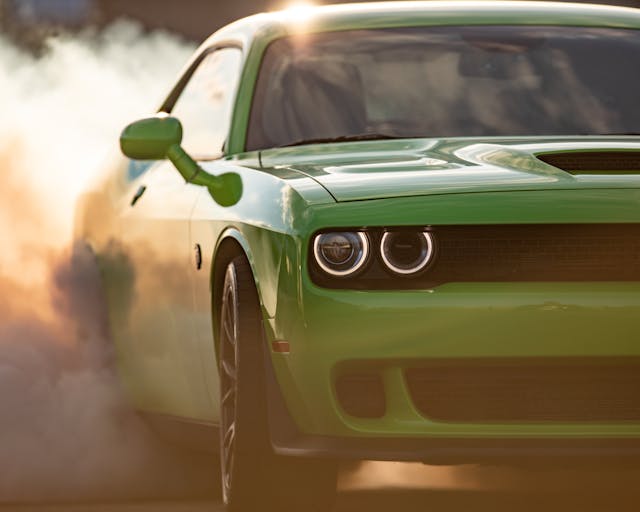
While the first two decades of catalytic converters would hold back ultimate power for those looking for serious engine upgrades, modern powerplants like Chrysler’s Hellcat prove that catalytic converters let you have your cake and eat it too.
Milestone #2: Luxury for the Masses
The personal luxury genre started in the 1960s with the likes of the Cadillac Eldorado, Continental Mark III, and even ritzy versions of pony cars (looking at you, Mustang Pony interior package). But those efforts pale in comparison to what we got in the Malaise Era. Because if you could afford a bit more than a new 1975 Pinto or Vega, well, you just got yourself a first-class ticket to Brougham-town.
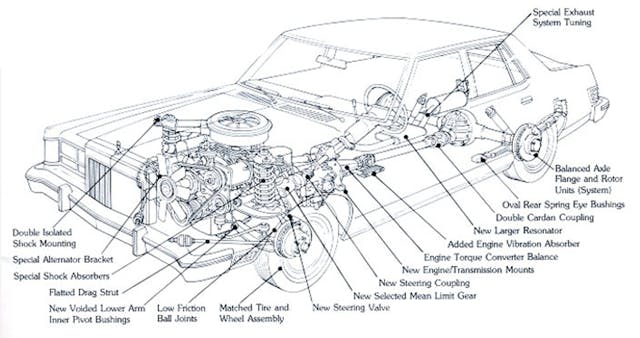
While the Brougham name became the butt of many a car enthusiast’s joke, the added luxuries were underscored with superior noise/vibration/harshness (NVH) reduction techniques: For starters, asphalt-lined sound insulation and thicker interior materials from carpets to door panels. The Lincoln Versailles above was the best and worst example of Malaise Era NVH engineering: It possessed significant upgrades from the era but a pathetic amount of parts was shared with its Ford stablemate.
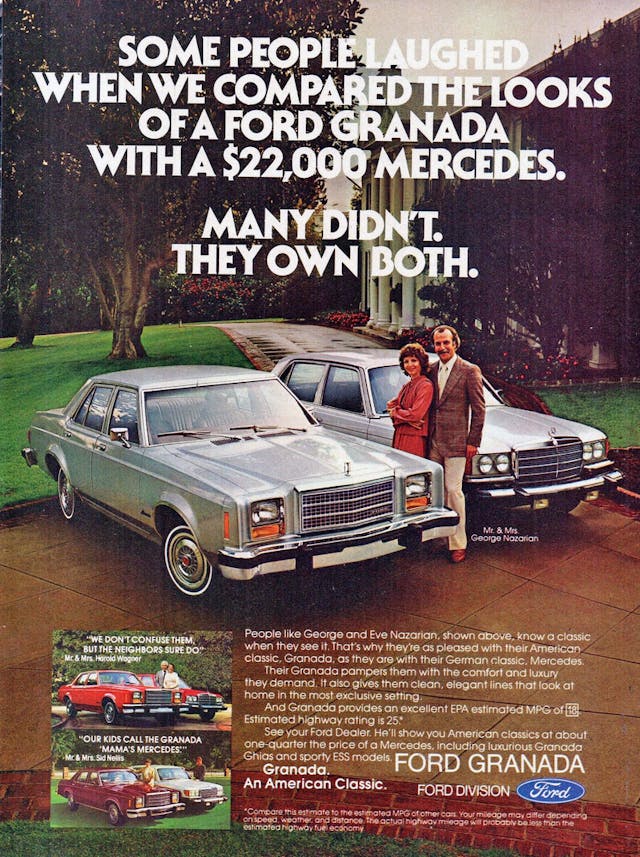
Speaking of Granada, Ford had the audacity to compare its new-for-1975 compact to a Mercedes-Benz W116. How on earth can something based on a 1960 Falcon platform, with a Falcon-derived engine and a stick axle, possibly be on the same level as a German flagship?
It clearly was not, but the Granada cost a reasonable $3800 for a base model. Even in full poverty-spec, the Granada had the telltale signs of a more premium vehicle from Germany or England, right down to the hood ornament, extensive chrome trimming, and an upscale interior with reclining seats, fake wood, and plush carpeting. We may pan Ford for its personal luxury references, but Chrysler (Dodge Aspen) and the fourth-generation Nova did the same thing.
Chevrolet bestowed significant NVH improvements upon the Nova in 1975, and the more upscale versions (LN and Concours) matched the, ahem, luxury of the Ford Granada. (The base 1975 Nova was about $800 less than a Granada.) And this Euro-centric commercial proves that General Motors was drinking the same personal luxury Kool-Aid as Ford.
Milestone #3: Lighter Land Yachts
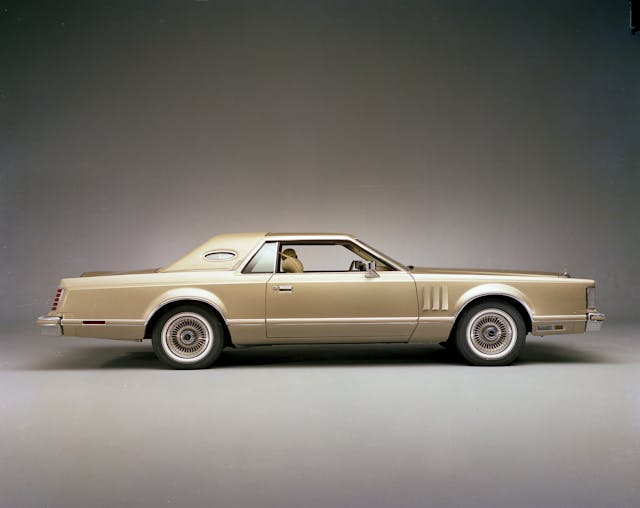
The 1977–79 Continental Mark V might be the only vehicle that’s both larger and lighter than its predecessor. While it’s a mere 2 inches longer, a 502-pound weight reduction is nothing to sneeze at.
The quarter-ton weight reduction came from heavy use of plastics in places you can see, like the revised plasti-fake wood trim, and the lightweight plastic/fiberglass front fascia holding its massive metal grille. But what amazed me was the weight reduction found in places your eyes shall miss.
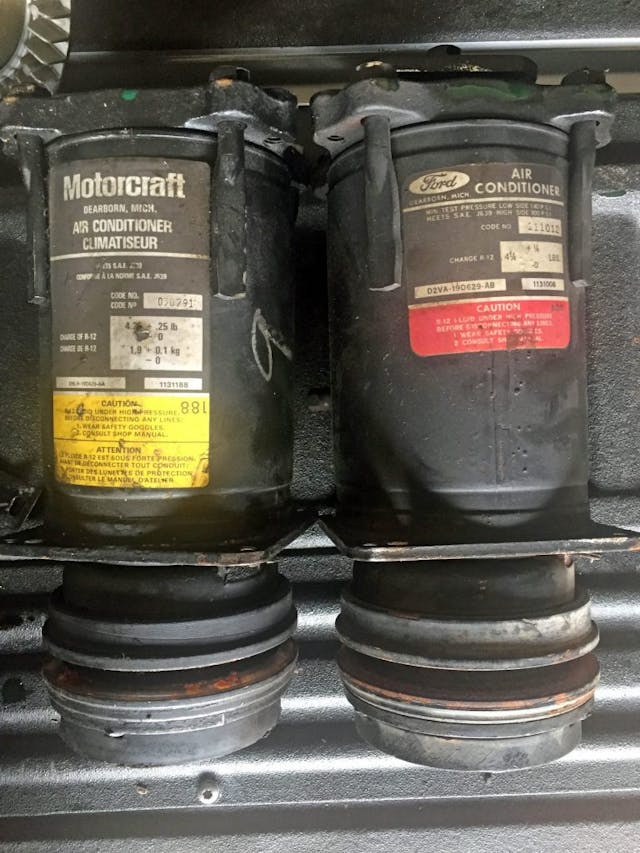
I own and restore both a Mark IV and a Mark V, and the best example of weight reduction that I’ve found are the respective A/C compressors. They may look the same externally, but the Mark V’s unit is roughly half the weight. My personal musings point to a broader trend: Malaise Era engineers were doing some heavy lifting (sorry) behind the scenes to make automobiles lighter. Or perhaps to offset the weight from those big bumpers?
Milestone #4: Bumpers That Bumped Back
For decades, Detroit designers treated the bumper as a mere styling feature, with body-hugging shapes and preposterous dagmars. The Malaise Era was a wake-up call for bumpers, getting them back to prewar duties of actually protecting the vehicle from damage. While the 1973 Pontiac Grand Am wasn’t the first car with the brand’s Endura nose, it proved the concept worked for legislation that required bumpers to become functional once more.
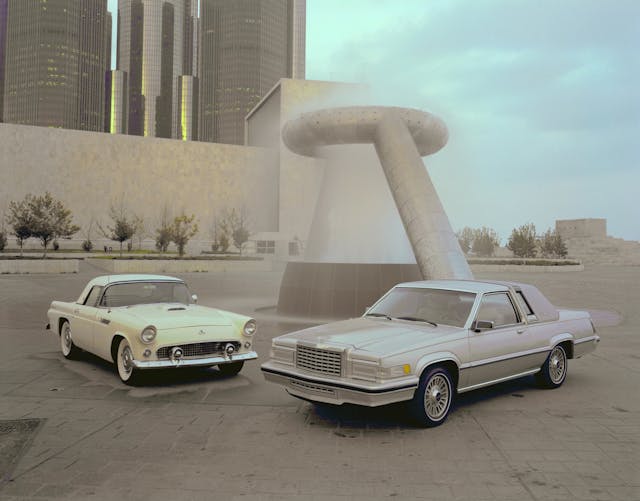
The plastic bumper had a future, as seen in the 1980 Ford Thunderbird. While this is one of the least desirable ‘birds of all time, its wrap-around bumper was trimmer than most chrome affairs and could still pass the second phase of bumper regulations that upped the damage threshold from 2.5 to 5 mph.
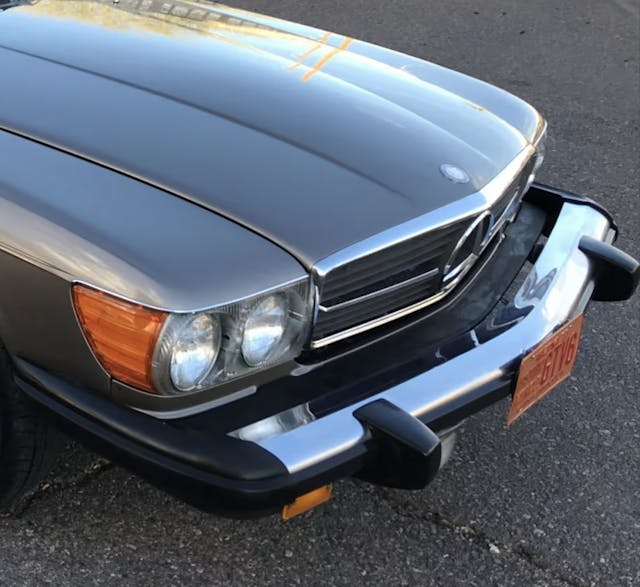
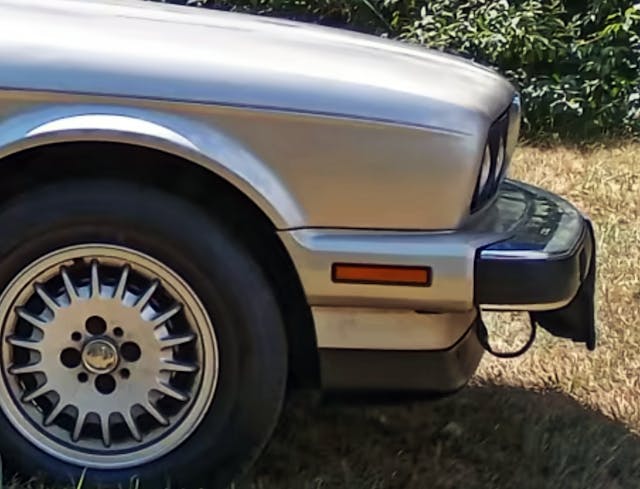
And what was the rest of the world doing? Behold the flagship Mercedes SL roadster, and Yuppie-level luxury BMW E30: Running around with battering rams years after the 1980 Thunderbird. But credit must be given to the 1982 Audi 5000, as its Thunderbird-like bumpers clearly pulled ahead of those worn by its German competitors.
Milestone #5: Adoption of Radial Tires

While the 1970 Continental Mark III (not from the Malaise Era) was the first American car with radial tires as standard equipment, Pontiac made a big deal about the benefits of radial tires in 1974 with its Radial Tuned Suspensions (RTS) for more affordable vehicles.
The radial tire’s softer ride (more sidewall flex), longer tread life, and lower rolling resistance made it the right move over the now antiquated bias-ply rubber. Tire manufacturers (save for the Firestone 500 debacle) wisely made the transition, as the writing was on the wall for all passenger cars. And speaking of lower rolling resistance …
Milestone #6: Better Fuel Economy
While much of this effort inadvertently reduced oil pricing shocks from OPEC during the Malaise Era, making lighter, sleeker, and more efficient cars really helped lower fuel bills for American motorists. One of the major improvements of this era was the large-scale implementation of the automatic overdrive transmission.
Ford released its Automatic Overdrive (AOD) transmission in 1980, while GM introduced the 200- and 700-R4 in 1981 and 1982 respectively. Chrysler’s A500 overdrive didn’t hit the streets until 1988, far after the demise of the Malaise Era. Chrysler’s belated efforts were still two years before Mercedes-Benz released the 722.5 overdrive gearbox (1990). While a stunning delay in overdrive implementation, Mercedes did cheat the system via tall axle ratios paired with shorter gears in a non-overdrive gearbox. (My experiences with them were disappointing, especially at less than full throttle.)
Milestone #7: Life-Saving Technology
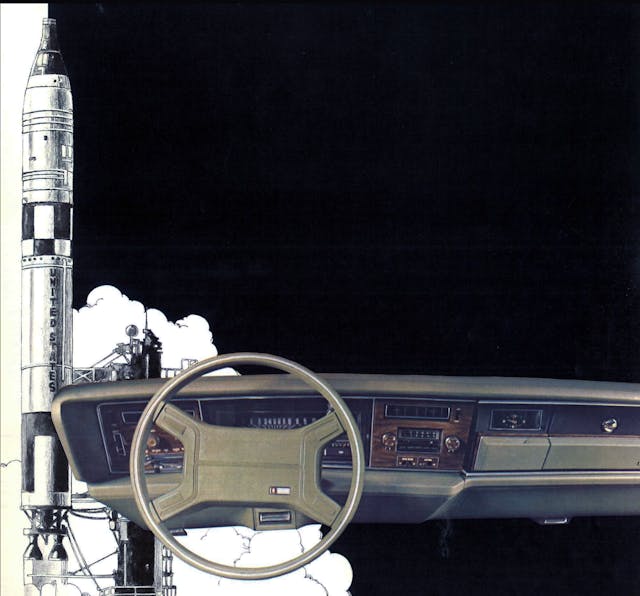
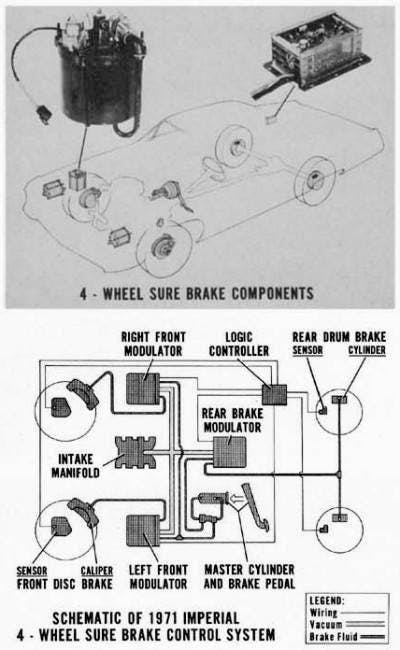
The days of lap belts, padded dash tops, and fully drum-braked vehicles were either gone or disappearing by the start of the Malaise Era. In their place we had three-point seat belts, fully impact-absorbing interiors, and front disc brakes (1975) across the board. It was good for both the future and the past, as countless first-generation Mustangs grabbed the front spindles and disc brakes from the aforementioned 1975 Ford Granada.
But there was much more to this era of automotive safety, as GM introduced the Air Cushion Restraint System (ACRS) in the 1974 Oldsmobile Toronado. (Mercedes was working on a similar system, which it released in 1980.) GM’s ACRS offered the modern airbag experience for driver, passenger, and center passenger occupants, while Chrysler sold the first four-wheel, computerized anti-lock braking system on an American car in 1971. (Yes, that’s technically before the Malaise Era.)
While these advanced safety systems were poorly received and suffered from short production lifespans, the post-Malaise technology boom made them palatable for everyone. Who knows how many lives ABS and airbags have saved in the last 30 years, but we have the Malaise Era to thank for all of them.
Milestone #8: Aerodynamics for All
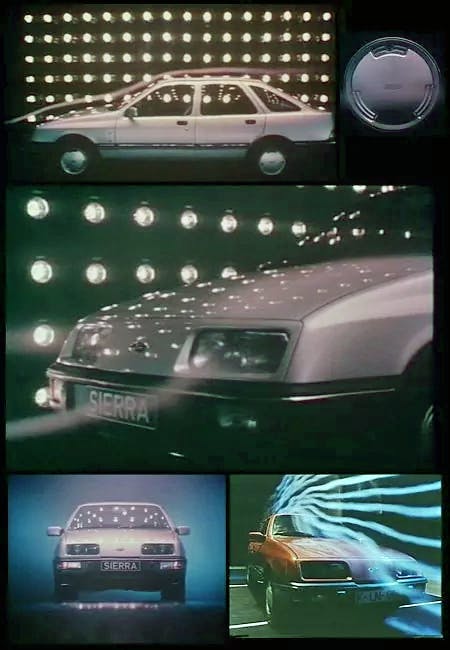

Wind tunnels have shaped cars since the Chrysler Airflow, but things didn’t get serious until Malaise Era demands put fuel economy on everyone’s mind. And one great way to lower fuel economy is to reduce the amount of fuel needed to push a car through the air.
Technology made plastics both lighter and cheaper in this era, quickly turning bumpers into tools for air manipulation. And it was indeed for all, as shown in cheaper cars like the German Ford Sierra (above) and traditional sports cars like the refreshed 1980 Corvette. That C3 Corvette infused front and rear aerodynamic elements from the 1978 Corvette Pace Car, lowering its drag coefficient from an awful 0.503 to a significantly less awful 0.443. (The C4 Corvette was a sleek 0.34, and that engineering technically happened at the tail end of the Malaise Era.)
Finding highway mileage ratings for the 1980 Corvette from the EPA was impossible, but the 1980 car did get an extra mile per gallon in the city over the 1975 model, rated at 13 mpg. Factor in the extra drag at highway speeds and it’s fair to extrapolate an even more significant improvement to the highway fuel economy of the 1980 Corvette; for 1975, that figure was only 20 mpg.
Milestone #9: Computers Outside Academia
Computers were still a flight of fancy in the Malaise Era, though some of us had an Atari 2600 or a Bally Home Library Computer by 1978. While I suspect the would-be Bill Gates of the world weren’t the target market for Cadillac’s Seville import fighter, the hardware that made home computing systems likely interchanged with Cadillac’s Trip Computer. This system showed everything from engine rpm to the Seville’s Estimated Time of Arrival (ETA) to a pre-programmed destination. It’s a great system that actually worked, and today everyone benefits from ETA calculations in our smartphone-based navigation systems.

That Seville also had a Bendix electronic fuel-injection system, but the other two Detroit manufacturers were taking a stab at in-house, in-car computer designs. The Malaise Era system that earned enough goodwill to stand the test of time is likely Ford’s EEC System, now in its seventh generation. The original EEC-I computer lacked the wattage to run more than a handful of sensors (often needing vacuum actuators for operation) but the die was cast, and engine computers were here to stay. Speaking of computers …
Milestone #10: Computer-Aided Design For All
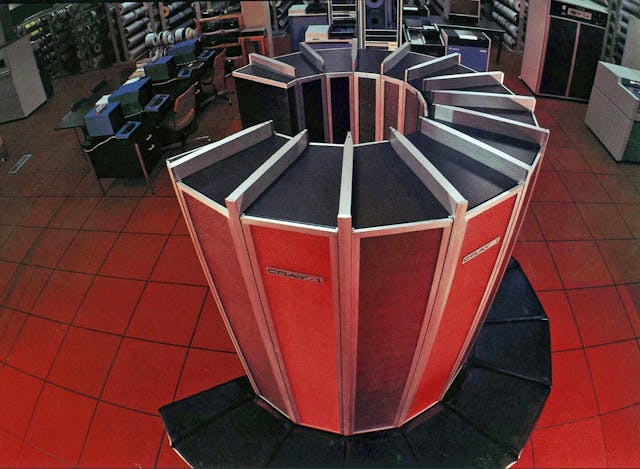
Supercomputers were all the rage in the 1970s, provided you had the millions of dollars needed to buy one. And they allowed for computer-aided design, a topic I previously wrote about that inspired this list of Malaise Era milestones.
Computer modeling opened doors to advanced design concepts like ergonomics, finite element analysis, and aerodynamic and crash-test modeling for all cars. The sheer number of doors opened by computers is impossible to count in our modern society, and I reckon most of those doors were worth opening. The portals pertaining to modern automobile innovations are “must sees,” and we can clearly thank the Malaise Era for bringing computer technology to our beloved automobiles.
So how do you feel about the Malaise Era now?
***
Check out the Hagerty Media homepage so you don’t miss a single story, or better yet, bookmark it. To get our best stories delivered right to your inbox, subscribe to our newsletters.
















Even mundane cars were loosing weight in the malaise era. The 1975 Grand LeMans had a composite header panel (SMC?) compared to the 1974 models steel one.
I HAD 2nd CARS SO I COULD KEEP MY MUSCLE MACHINES IN STORAGE DURING MICHIGAN HARSH WINTERS. 1977 & 1978 OLDS 88’S, AND 1984 BUICK. SAME UNDER PINNINGS DIFFERENT SHEET METAL. SAME PROBLEMS THOUGH, TRANSMISSIONS REPLACED IN THE ’77 &’84. THE ’78 HAD ROCKER REPLACEMENT, LACK OF OIL. PUSH ROD OIL HOLES WERE VERY SMALL. FIXED THAT BY INCREASING THE SIZE OF THE PORTS BY DRILLING THEM OUT JUST A HAIR. ROOMY, NICE RIDE, GOOD LOOKING CARS TOO. MY FAVORITE OLDS IS THE ’85 88, THEY USED UP LEFT OVER 98 TRIM PARTS AS THE 98 WAS DOWN SIZED A YEAR EARLIER. MADE THE 88 A BIT MORE STYLISH.
The Malaise era extended well beyond 82/
I grow very tired of younger journalists and the population in general seeing the past in terms of clichés alone. This sounds so much like the same auto journalism of the period who would lament endlessly about how the odd and quirky imports of the time with their specialty mechanic and cramped quarters were better than my Dad’s Granada or my Uncle’s Royal Monaco because they cornered and stopped quicker. The same folks who will tell you until they were blue in the face that everyone listened to disco and wore bell bottoms that could hide your children while they clung to your ankles. If you weren’t there and take your knowledge from Tarantino movies please refrain from suggesting you have a clue what your speaking about. It’s like assuming all women in the 50s wore poodle Skirts and all of the guys had duck tail haircuts. My folks loved their Nova, Chevelle, and Granada. Dad even loved his Pontiac Astre until over 90,000 miles when it finally showed it’s limits. My uncle loved his Monaco and the Grand Fury before that. There was never any disco in our home or car radio. Usually Waylon and Willie were played by my Dad. Later when I learned to drive it was 70s cars that were affordable and that I drove. The stereos played the real music of the 70s. Led Zepp, the Doobies, Ziggy, Supertramp etc. You missed an era of comfortable cars that took the whole family on vacation and pulled a boat behind while Fleetwood Mac was on the 8 track. You missed it. deal with it. I love performance and handling as much as any gear head but I often consider how nice it would be to take a cross-Canada vacation in a 70s Lincoln or Buick or even a nice ’76 Monte Carlo and arrive relaxed. …or even a Cordoba with a box full of 8-tracks.
If you love fords like me every one knows the 1977 78 79 Lincoln mark 5 is the end of a great era . By 1980 everything really changed in the car world. I have a car a collection and I always have at least one mark 5 , in my opinion it was the best looking Lincoln of all , I’ve had a lot of different Lincoln’s it ALWAYS gets the most attention at shows
Milestone #11 should have mentioned that only Chrysler Corp. was able to genuinely meet the CAFE Standards enacted in 1975. Without a whimper or a complaint. Unlike the other 2 manufacturers.
We had cars from that era. The ’78 Delta 88 was a good running and riding car. I still think a ’76 Cutlass Supreme with even the low compression Rocket 350 is a really decent car. There were plenty of other cars that were might marginal or crappy though.
You can try to give away a GM car but nobody would take it.